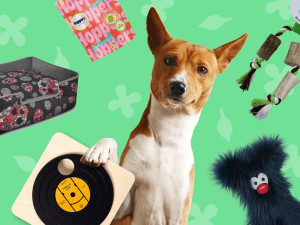Yikes, Your Dog’s Toys May Be Toxic
For starters, many tennis balls for pets are loaded with lead and arsenic.
Back in 2007, nurse and dog mom Nancy Rogers had a hunch and hired a laboratory to test the lead content in 24 of her Sheltie’s chew toys. The tests revealed that her dog’s tennis ball contained 335.7 parts per million (ppm) of lead — an amount that, at the time, fell far below the levels allowed in children’s toys. Today, however, that amount exceeds the 100 ppm federal standard for lead in children’s toys.
What amount of lead should be allowed in the toys dogs lick, chew, slobber, and shred? Do toys with relatively high levels pose any harm to our pets? These questions were — and still are — at the heart of Rogers’ frustration. When those tests were run, there were no standards for lead or other toxins in pet toys. And 15 years later, there are still no federal regulations.
Save on the litter with color-changing tech that helps you better care for your cat.
Dog Toy Safety Standards (or, lack thereof)
While the Consumer Product Safety Commission checks for the safety of toys for human use, there is no mandatory or voluntary standard for pet products. “We can test and measure all we want, but until we have standards, it’s hard to evaluate what those levels mean,” says Rogers. Many in the pet industry agree there should be guidelines for lead and other worrisome chemicals in dog toys. They share Rogers’ safety concerns, which surfaced in the wake of the recall of melamine-tainted pet foodopens in new tab, toxic rawhides dog chews, and amid growing concerns about lead in children’s toys from China.
Some players in the pet industry downplay the need for chemical standards in these products, stating they aren’t aware of any studies linking lead in dog toys to canine-related health problems. They also say some companies that make pet toys now follow the federal standards for lead in children’s toys — or the European standards, which was reduced to 23 ppmopens in new tab as of 2018.
“It may sound like standards make sense, and they may make consumers more comfortable about buying a pet toy, but there are no indications that there is a real risk to pets [from lead and other toxins] in their toys,” said Ed Rod, former vice president of government affairs for the American Pet Products Associationopens in new tab (APPA). “We have over 1,000 members, and we’ve heard no reports of dogs or cats having any ill effects from playing with any pet toy because of the lead or the plastic in the toy.”
Toxic Dog Toys
But tests performed of hundreds of pet toys, tennis balls, beds, collars, and leashes have revealed that many contain what researchers call “alarming levels” of lead and other harmful chemicals. Michigan-based Ecology Centeropens in new tab, a nonprofit environmental organization that analyzes toxins in children’s toys and other consumer goods, posted results on their site. While the site explains that the project’s screening technology “cannot identify the presence and concentration of every chemical of concern” (BPA, for example), some key findings are worth noting:
• From the more than 400 pet products tested, 45% had detectable levels of one or more hazardous toxins, including arsenic, chlorine, and bromine. Studies have linked those chemicals to reproductive problems, developmental and learning disabilities, liver toxicity, and cancer.
• Of the tennis balls tested, 48% contained detectable levels of leadopens in new tab. Researchers discovered that tennis balls made specifically for pets were more likely to have lead than “sports” tennis balls. The lettering on one “pet” tennis ball, for example, contained a whopping 2,696 ppm of lead and 262 ppm of arsenic, a known human carcinogen. Curiously, none of the “sports” tennis balls tested contained any lead.
• While one-quarter of all the products had detectable levels of lead, seven percent of all pet products had lead levels higher than 300 ppm. Nearly half of the pet collars tested had detectable levels of lead; 27% had lead levels that exceeded 300 ppm.
“Pets are involuntary canaries in the coal mine in terms of chemical exposureopens in new tab,” says Jeff Gearhart, research director at the Ecology Center. “Pets, like children, have higher exposure to chemical hazards, and our data show that pet products are far more likely to have hazardous chemicals than children’s toys.”
Not all the dog toys tested, however, contained harmful chemicals. Researchers discovered more than a dozen “chemical-free” toys — including the Air Kong Squeaker, the Hartz Flexa-Foam Round About Elephant, and the Nylabone Double Action Chew. Despite these safe findings, Gearhart says his organization’s tests illustrate why chemical safety standards are needed for chew toys and other pet products. The standards would not only protect pets, he says, but also young children who might put dog toys in their mouths. “For lead, the standard that applies for children’s toys is appropriate for pets,” he says. “I’d say the standard for children’s products should at least be a starting point for those levels.”
Health Concerns of Long-Term Exposure
Dr. Safdar Kahn, a veterinary toxicologist and director of Toxicology Research at the ASPCA Animal Poison Control Center, agrees. “Dogs are part of the family. They are as important to us as our kids or other family members, and if we feel that way about them, then we should give them things that won’t affect their health,” she says. “So, just like there are guidelines for children’s toys, there should be guidelines for [toxins] in the toys being sold for pets.”
Dr. Kahn isn’t aware of any confirmed cases of lead poisoning in dogs caused by a pet toy, but he warns that long-term, excessive exposure to the heavy metal could cause health problems in our four-legged friends. “Dogs like to chew on things, lick things, carry toys in their mouths, and if there are excessive amounts of lead in a toy, then they can get overexposed to lead,” he says. “And lead can do a number of things to dogs, depending on how much they’re exposed to and for how long.” Some health problems associated with canine lead toxicity include vomiting, weight loss, anemia, seizures, and permanent neurological damage.
“Depending on how much exposure there is, and the duration, it can affect multiple organ systems,” Kahn adds. Remember the “pet” tennis ball that contained more than 2,000 ppm of lead and more than 200 ppm of arsenic? “They are considered higher than the maximum tolerable dietary levels in dogs,” says Kahn. But the levels of other toxins found in the pet toys tested by the Ecology Center — including traces of chromium, antimony, and up to 166 ppm of the flame-retardant bromine — do not alarm Kahn. “Those are not expected to be a concern at these levels,” he says.
The Future of Dog Toy Safety
The American Pet Products Association (APPA) maintains its members are vigilant about the safety of dog toys and other pet products. The trade group says many of its members have adopted their own chemical standards, using the European or United States lead levels as baselines. “There is a kind of informal standard going on now,” said Rod. “Some of our members have also found that large retailers impose their own standards. But some members have run into difficulties because those standards are not always the same. Retailers set their own standards. One company may have one standard and another retailer may have another one.”
Do APPA members agree that national standards for toxins in pet toys should be adopted? “There is discussion in the industry about whether some sort of voluntary standards are appropriate,” said Rod. “We’ve met with the Consumer Product Safety Commission (CPSC) about getting some standards. But the CPSC has no jurisdiction over pet toys, and they are underfunded and overworked. They have no interest or inclination unique to pet toys. They’re looking at children’s toys. So going to the CPSC and getting some standards for pet toys is not an option.”
Rod says members of his organization understand pet parents’ concerns and frustrations about toxins in their pets’ toys. “People saw Mattel recall toys for lead and heard about the lead problems with the Thomas the Tank Engine toys,” he says. “The next connection was, understandably, ‘What’s in my pet’s toy?’”




